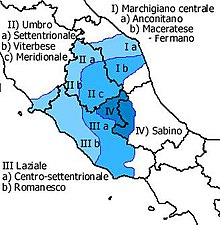
The Central-Northern Latian dialect (Laziale centro-settentrionale[1]) is an Italian dialect belonging to the Central Italian dialects, of which it represents the southern offshoot.[2]
Territory[edit]
It is spoken in the Lazio (Latium) region, and in particular in the northern areas of the Province of Frosinone (whose variants are often improperly defined as the Ciociaro dialect or more anciently Campanino[3]), in the central-northern areas of the Province of Latina and in most of the Metropolitan city of Rome[4] with the exception, however, of the city of Rome, where the Romanesco dialect is widespread and which differs widely from the rest of the Latian dialects.
Features[edit]
Phonetics[edit]
The central-northern Lazio is characterized, like the other Central Italian dialects and the Tuscan dialect (but unlike the neighboring Southern Latian dialect and most of the other Italian dialects), by the presence of seven vowels, also typical of standard Italian.[5]
The Judeo-Roman dialect[edit]
The Judaic-Roman dialect can be inserted within the Central-Northern Latian dialect, having diverged considerably from the Romanesco dialect after the establishment of the ghetto in 1555 and therefore not undergoing the influence of the Tuscan as strongly as the dialect of the capital.[6] The dialect is now used for literary and theatrical works.
See also[edit]
References[edit]
- ^ N. Zingarelli, Il nuovo vocabolario della lingua italiana, 1983, p. 542.
- ^ Pellegrini G. B, Carta dei dialetti d'Italia, Pacini ed., Pisa 1977
- ^ Anon., La vita di Cola di Rienzo, ediz. 1828
- ^ Pellegrini G. B, Carta dei dialetti d'Italia, Pacini ed., Pisa 1977
- ^ M. Loporcaro, Profilo linguistico dei dialetti italiani, Laterza, Bari, 2009, p. 134.
- ^ On this dialect, see: Migliau Bice, Il dialetto giudaico-romanesco, in: Migliau Bice e Procaccia Micaela, Lazio: Itinerari ebraici. I luoghi, la storia, l’arte, Marsilio, Venezia, 1997
Further bibliography[edit]
- C. Vignoli, Vernacolo e canti di Amaseno, I dialetti di Roma e del Lazio, I, Società Filologica Romana, Roma, 1920
Well, that’s interesting to know that Psilotum nudum are known as whisk ferns. Psilotum nudum is the commoner species of the two. While the P. flaccidum is a rare species and is found in the tropical islands. Both the species are usually epiphytic in habit and grow upon tree ferns. These species may also be terrestrial and grow in humus or in the crevices of the rocks.
View the detailed Guide of Psilotum nudum: Detailed Study Of Psilotum Nudum (Whisk Fern), Classification, Anatomy, Reproduction